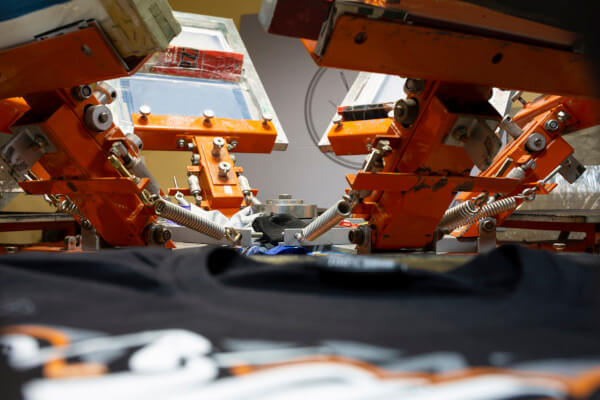
Screen printing is a beautiful, versatile means to brand and decorate items. Screen printing can be used on shirts, pants, bags, flags, binders, ceramics, wood, glass, electronics, signs, displays, and even sports equipment. However, how many of us have those t-shirts—the cracked, peeling, faded printed t-shirts at the back of the closet or perhaps a kitchen cabinet shelf filled with once-favorite drinkware that the logo has faded or completely worn off?
Chances are, there are many of us who no doubt have experienced some of our favorite screen-printed items begin to fade, crack, peel or wear off. Unfortunately, not every screen printing service or shop follows the same quality standards as others. Not every screen-printing business is alike. Materials, inks used, and practices all differ. Regrettably, not all of them employ suitable methods or use good equipment, some believing that the cheapest ink and materials will do. These practices often result in those t-shirts that crack, peel, or fade in a few washes—or the favorite tumbler with your favorite logo on it washing away after a few uses.
So with proper equipment, processes, and suitable inks, how long will screen printing last?
What is Screen Printing?
Screen printing, also known as silk screening, is a method for printing art, logos, brand names, and graphics on objects using thick inks. A thin mesh is stretched tightly over a frame, and a negative of the design is printed onto the screen. Next, it is placed directly against a product, like a shirt, for example. Once everything is set correctly, ink is rolled over the screen, and only the areas where the design has been printed allows the ink to slip through onto the shirt. Once this process is finished, the shirt or item is placed aside to dry or cured with a flash cure or exposure unit.
This is a somewhat simplified version of screen printing, as there are other complexities involved, such as which kind of ink is used, what sort of chemicals are involved, and the techniques—but the above is the general aspect of screen printing.
What Makes Screen Printing Last or Fade?
What influences the longevity of a screen-print often comes down to how the screen print is cured. You may have heard some interesting stories from DIYers and tiny business owners. They have just undertaken the screen printing business using the kitchen oven, an iron, a flash cure, or even a heat gun from a local hardware store. Sadly, neither of these options will cure or help the longevity of a screen-printed product properly and will likely lead to production suffering.
The truth is, there are no valuable shortcuts when it comes to curing. When it comes to ensuring your screen prints last longer than the products you place them on, it requires careful investment in excellent equipment. Namely:
- Exposure Unit
- Belt Oven or Conveyor Dryer
- Infrared Flash Cure Unit
The proper curing unit all depends on the type of ink that is being used in the screen printing process as well. The two basic and most used ink types you’ll find used for screen printing are plastisols and water-based ink. Here’s what it takes to cure the ink for a long-lasting design successfully:
- Plastisol ink: The industry standard and known for its opacity and durability. Most plastisols cure at 320 °F, with some as low as 280 °F.
- Water-based ink: Known for a soft hand and color. Water-based inks use a solvent to carry pigment and require evaporation to cure correctly, so they must have longer dwell times. Anywhere from 90 seconds up to several minutes with curing temperatures ranging from 300 ° F to 360 °F.
But once a screen-printed item is cured correctly does not mean the thing is ready for sale or shipment to a customer. The next step of a screen-printed item is called a “wash test.” For professional screen-printers, this is the go-to and industry standard to guarantee the quality of a print and double check that the piece is correctly cured and that the curing units used are functioning properly. A wash test is conducted for many items, especially those with special effects, textures, metallics, or gel inks, ensuring that no ink is removed or washed away. The screen-printed product is adequately cured and will be long-lasting.
The next test most professionals will conduct is called a “stretch test.” Typically, a screen-printed piece of fabric gets stretched around one-half the full stretch of the material where the print has been placed. It is then checked for any cracks or peeling. If the image retains its shape when the fabric has been relaxed, the ink has been cured correctly.
So, How Long Does Screen Printing Last?
So long as you purchase screen-printed items from experienced, professional printers, a screen-printed item should last as long as the item itself and perhaps even longer. For example, if your product is a screen printed shirt, the screen-printed graphic or art on that should last you as long as that shirt, and in most cases, remain crisp and vivid well after the shirt’s lifespan!
Unlike transfers or other types of printing, screen printing doesn’t just sit on top of garments. The ink penetrates deep into the material and then is cured within it. Pair proper curing with the correct care for the item and apparel, and many happy customers have reported their products lasting decades or longer.
Professional screen printing should never fade, crack or peel easily, which is why quality control is an essential step for us at MSPDesign Group. With more than 3 decades of experience in printing and promotional services, we use nothing less than the best inks, cutting-edge curing technology and meticulously test each of our products. Our mission is to provide brands and organizations large or small premium, long-lasting and durable screen printing that is made to withstand years.
If you’re ready to elevate your brand to new heights, we’re excited to help you with our beautiful screen-printing options today. Reach out to us at any time for beautiful branding that will last for years.




